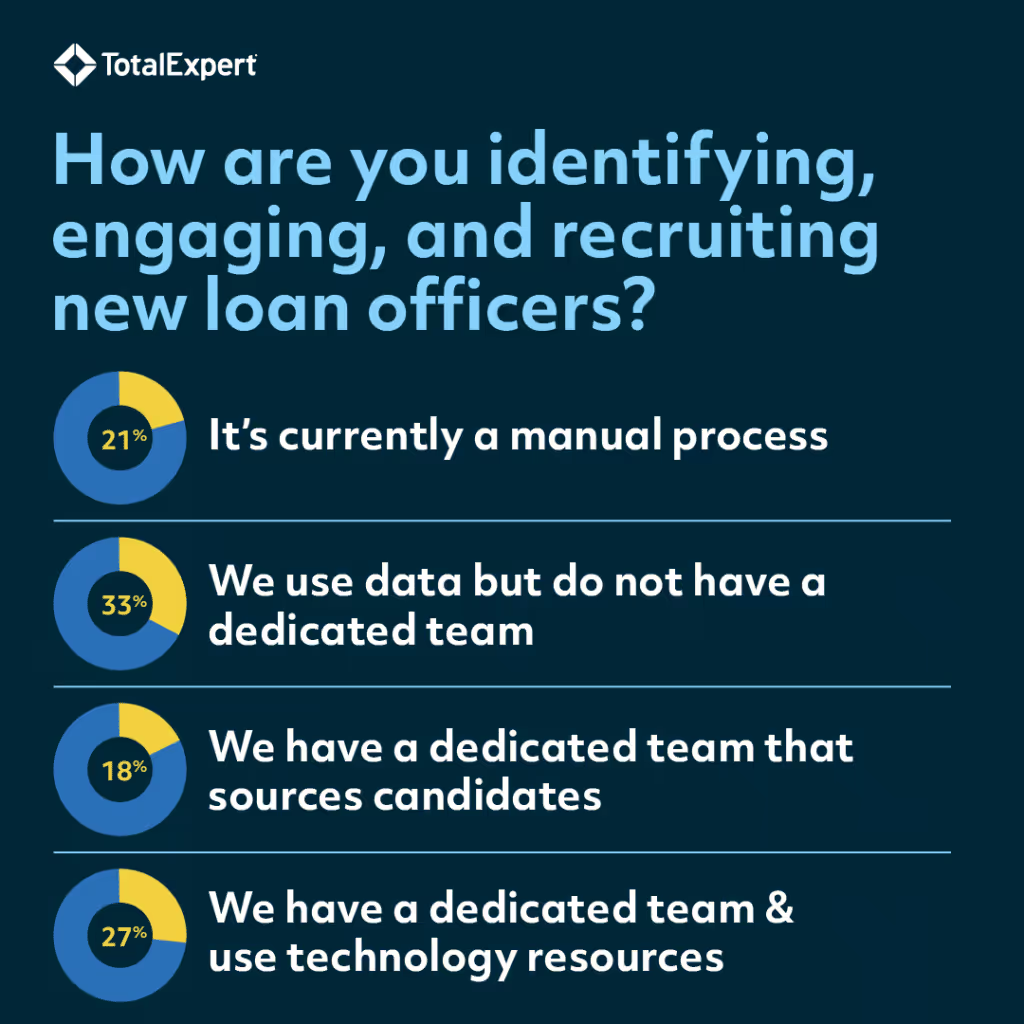For years, the Total Expert and InGenius teams have worked closely to tackle one of the biggest challenges that lenders across the U.S. face every year: How do you build a team of high-producing originators—and nurture a pipeline of loan officer talent? As the market continues to evolve at a historic pace, competition for the best producers is increasing, but convincing them to move their book of business hasn’t gotten easier…until now.
We sat down with InGenius CEO Jeff Walton to discuss how their latest innovation—LoanView Connect—helps rehydrate loan officer databases to break down one of the last remaining barriers in recruiting and onboarding.
Changing dynamics amplify the focus on top-end producers
As with so much of the business world, the Pareto Principle holds very true in mortgage lending. “The top 20% of originators are doing 70% of all production—and the top 40% are doing 88% of all production,” said Walton. “That wasn’t always the case. If you look over time, it’s moving toward concentrating at the top.”
This concentration changes the way lenders need to think about building a team. Conventionally, it used to be a safe bet to build a deep bench of solid loan officers—contributors that weren’t superstars but were consistent. That mid-tier “bench player” doesn’t really exist anymore, as Walton pointed out through the data. The question then becomes, “How do you build a team that leans heavily toward that top end of the spectrum?”
Moving beyond legacy approaches to recruiting
Lenders’ goals and the recruiting landscape have changed, but it’s been harder and slower to change the recruiting process or approach within the typical mortgage lender. An informal poll of our webinar attendees showed that 1 in 5 are still managing recruiting on a fully manual basis (no data or technology), and 73% don’t have dedicated staff or technology to support loan officer recruiting.

This isn’t all lenders’ fault. Until recently, they haven’t had access to the data and intelligence needed to properly inform and support their recruiting efforts. “It was harder to understand what an originator was producing and what their volume was,” said Catinella. More recently, lenders started to get access to this kind of data. “But it was very one-to-one: Sales managers were using tools to look up info on a single originator. It wasn’t scalable,” he says.
Using data to identify—and retain—the right talent
Walton explained how leading innovators like InGenius are now ingesting tremendous amounts of market data—and transforming that data into usable, actionable intelligence to inform lenders’ loan officer recruiting. Forward-thinking lenders are already utilizing this data to identify producers that are a good fit for their organization and its goals.
“You can use dynamic filters to select people where your strengths align with theirs,” Walton said. “For example, if you’re an IMB and you don’t have a great jumbo offering, you’re going to filter for less jumbo product. If you’d like to see at least 20% FHA or VA production, you can set those standards so that you’re looking at people whose production lines line up with what you want. If you want to just go after bank loan officers or credit union loan officers, you’ve got to be able to filter the data to drill down to those people that will make you more successful.”
This data-driven targeting isn’t just about getting good loan officers but keeping good loan officers. Bringing in talent that aligns with your strengths also gives existing loan officers a better setup for success, creating a mutually beneficial relationship. “You’re creating long-term, tenured loan officers who continue to produce year after year,” said Catinella, “Which is important because you spend a lot right out of the gate to get originators in or build out new branches. So, you want to make sure you’re bringing people into the organization that are going to stick around.”
Removing onboarding barriers with LoanView Connect
InGenius’ latest innovation, LoanView Connect, eliminates some of the biggest hassles—and legal concerns—faced during recruiting and onboarding by allowing loan officers to rebuild their databases dating back to Jan. 1, 2019. By ingesting loan-level, closed transaction details, and contact information, InGenius removes litigation exposure from the equation while streamlining the onboarding process.
Building data-driven growth strategies
Using data intelligence like InGenius delivers can also help mortgage lenders determine what their strengths and recruiting strategies should be in the first place. “InGenius reverse-engineers the deed data, so you can see your production on a month-over-month, real-time basis,” explained Walton. Lenders don’t have to wait until the end of the year to see how they’re performing across different products or demographics. For example, lenders can see how they’re doing in low- to moderate-income census tracks or majority-minority census tracks. If they see an area that requires attention, InGenius can show them the loan officers, the real estate agents, and the customers who have mortgages in those census tracks. “It’s very, very powerful data to be able to improve your market share in those census tracks,” Walton said.
Catinella pointed out another way to use data to shape recruiting strategies: “InGenius can show you who you’re gaining loan officers from—and who you’re losing loan officers to. That kind of competitive information is powerful to have at your fingertips.”
Moving from local to centralized recruiting
Besides the tactical ways to use data, Walton highlighted the need to centralize recruiting as one of the most fundamental changes every lender must make. “Recruiting used to be decentralized—individual branch managers hearing about a producer in their area and picking up the phone to call them or meet for lunch,” Walton explained. “That’s personal, but it’s not scalable.”
He sees the most successful recruiting take a collaborative, centralized approach: First, lenders build a centralized recruiting team that’s able to use the data to define loan officer recruiting strategies. Then, they’re working with their marketing teams, who have the tools and skills to execute those strategies and engage with the right loan officers. “It’s about centralizing and then acting on the data—at scale,” Walton said, “And if you’re not doing that, you’re going to fall into that bottom 60% of mortgage lenders.”
Part of this centralization revolves around—and can be dramatically accelerated by—technology. Catinella pointed out that many lenders have (or think they need) isolated platforms just for recruiting. This leaves a disconnect between the centralized recruiting team and the local sales managers that are “closing” on loan officer recruitment. “Recruiting is still a team sport,” Catinella said, “You need to involve your local sales managers, and having them all in one system with your recruiting team helps you maximize your resources and makes it easier for them to collaborate in building an engaging, personalized journey that’s just like the experience they’re building for your borrowers.”
Building loan officer relationships to be there when it counts
Even with smart targeting and coordinated outreach, lenders can’t expect to land their top prospects right out of the gate. “90% of the time, they’re not interested in moving. Because loan officers don’t want to move companies. It disrupts business,” said Walton. “But what you have to do is show up consistently, so when they do have a disruption or have to move, you already have that awareness, have a connection, have a relationship.”
That’s where connecting the powerful data from InGenius with a purpose-built system of action like Total Expert is critical. “You couldn’t do that kind of ongoing engagement in the old days on an analog basis,” Walton said, “But today, you can scale and show up on a consistent basis, so you’re right there when the opportunity arises.”
Making change easy for loan officers
Another important way to combat loan officers’ anxieties around changing teams is to build strategies around making that transition as quick, seamless and painless as possible. Of course, this claim is nothing new: “Loan officers have all heard ‘We’re going to take care of you,’” said Walton, “So, you need to show them how you can take steps to actually deliver on that promise.”
One of the most unique capabilities of the InGenius solution gives lenders a big competitive edge. InGenius can automatically rebuild or “rehydrate” an originator’s database, based off public records and other data sources they tap into. This means loan officers don’t have to worry about losing this valuable information if they come onboard—and they don’t have to worry about the legal considerations of bringing over their old data. Moreover, InGenius can improve loan officers’ data, bringing it up to date.
Walton explained that lenders can show loan officers how they can fully recreate (and improve) their database.
“You can tell them, ‘We have really, really good data. Now, we can add your data into our Total Expert system, so that the day you walk through the door, we’re already marketing to your customers—building journeys specifically for you and your customers, so you can stay in touch, get those referrals, and ensure retention.”
Jeff Walton, InGenius CEO
Catinella emphasized the importance of reducing onboarding friction. “When I was working to recruit top producers, we would show them how the Total Expert system could cut down the time from when they’re hired to when they create the first application in the system,” he said. We would strive to shrink that to under a week—or even days or hours.”
Why now is a critical time for recruiting
It’s undoubtedly been a tough few years for mortgage lenders, with high rates and rising home costs creating a vicious cycle that’s holding back home sales. These macro factors are reflected in the numbers on the nationwide loan officer talent pool: The market peaked in June 2021, when a record-high 177,991 loan officers closed at least one loan. We started to see compression about 18 months ago, right as the duo of rising inflation and rising rates hit the housing market. That cut the number of producing loan officers almost in half—down to 93,938 in January 2024. To put those numbers in context, the pre-pandemic “normal” was around 131,000 producing loan officers.
The good news is that we’re starting to see signals that consumers are getting tired of waiting for rates to drop. March saw the highest jump in home listings since June 2021—and a 10% bump in mortgage applications. “We’re already seeing a lot of Total Expert customers ramping up their recruiting,” said Catinella. His insight was reflected in another poll, which showed over half the webinar attendees were planning to add more than 15 loan officers over the next 12 months—and 21% plan to add more than 30.
As the housing market begins to turn around and recruiting and hiring returns as a major focus, lenders need to focus their attention on building smart, strategic, and scalable frameworks. “Lenders should be looking at that as an opportunity,” said Walton, “We’ve got a lot of hiring to do as we get back to normal, so that means a lot of recruiting.”
But to make the most of that opportunity, lenders need to make sure they’re approaching loan officers recruiting the same way the most successful lenders have reimagined customer engagement. That starts with using data to identify the right people—high-performing prospects that align with your organization’s focus and strengths. And those opportunities are realized by connecting that data with a system of action.
Thanks to Total Expert’s partnership with InGenius, lenders can put those two ingredients together—the loan officers recruiting intelligence and the scalable, automated action—in one platform to build out recruiting journeys that string together automated messages and human touchpoints. This is the key to balancing the need to be extremely targeted and hyper-personalized with your outreach while also scaling up your recruiting efforts.

